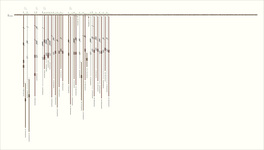| Notes: |
Ascher Databook Notes:
- The distance from $ to pendant 1 was not recorded. All main cord measurements begin at pendant 1.
- This is one of several khipus acquired by the Museum in 1907 with provenance Ica. For a list of them, see UR1100.
- By spacing, the khipu is separated into 4 groups of 2, 2, 12, and 11 pendants each. In the 3rd group, the pendant colors alternate W or B, RB; in the 4th group, they alternate B, W, for 3 pairs and then are all W. There are no subsidiaries in the 3rd group, and in the 4th group, there are 2 subsidiary positions. Where there is one subsidiary in the higher position, it is RB; where there are 2, they are RB, MB. Each subsidiary in the lower position is LB.
- The pendant values in groups 1 and 2 are related to the sums of the values in groups 3 and 4.
- The sum of the values on all W pendants in group 4 = the sum of the values on odd alternate positions in group 3 = the value on the second pendant in group 2.
- The sum of the values on all B pendants in group 4 = the value on the second pendant in group 1.
- The sum of the values on all RB subsidiaries in group 4 = the sum of the values on even alternate positions in group 3 • the value on the first pendant in group 2. (The group 3 sum has a discrepancy of 2.)
- The value on the first pendant in group 1 may equal the sum of the values on MB subsidiaries in group 4. The MB subsidiaries are broken and their's are the only unaccounted values.
- Assuming the above (d):
- The sum of the values on all pendants in group 3 = the sum of the values on the pendants in group 2.
- The sum of the values on all pendants and subsidiaries in group 4 = the sum of the values on the pendants in groups 1 and 2.
|









